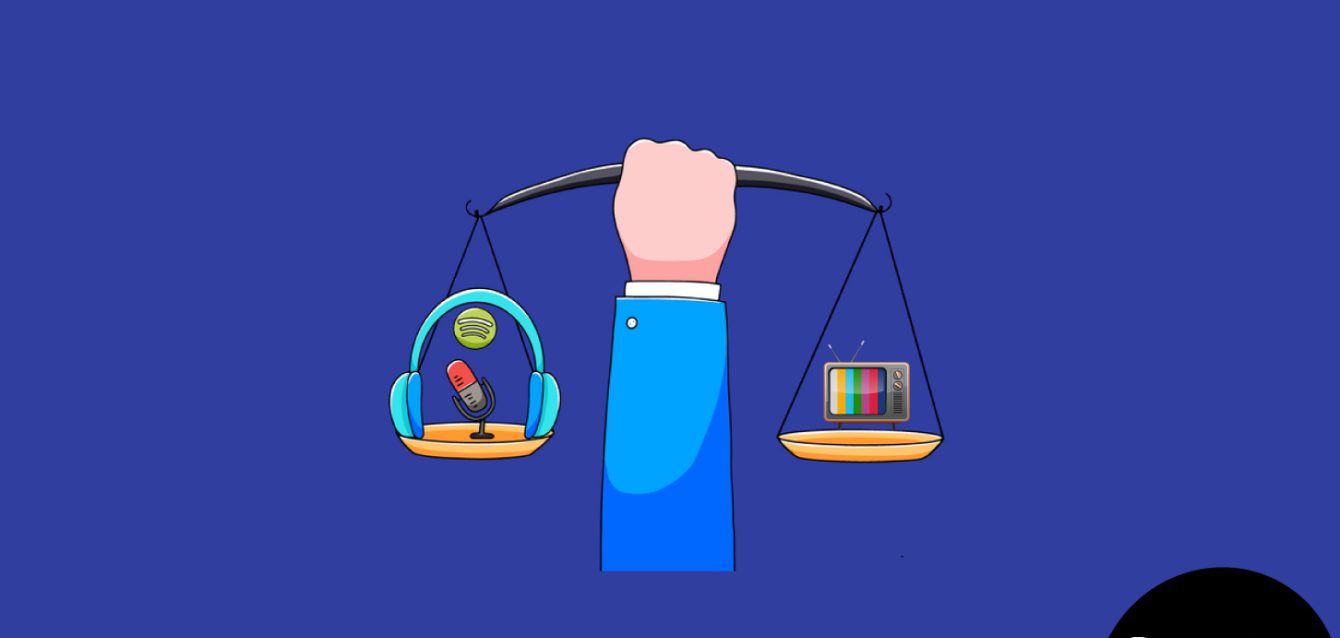Comparison Between News Podcasts and Traditional Media: Who Wins?
Some might think comparing news podcasts to traditional media is unfair, believing that podcasts exist solely for entertainment. However, this must be clarified, as podcasts can spread knowledge and information alongside entertainment.
Comparing news podcasts to traditional media highlights several critical differences between them. Here are the most significant ones:
A Detailed Comparison: Tangible Factors and Core Differences
Let’s first explore the prominent factors that come to mind when comparing news podcasts to other traditional media.
- Flexibility and Availability
- Traditional Media: Time constraints are a significant challenge regarding flexibility and availability in conventional media. Although some traditional media have started offering subscription-based services and internet use, this culture still needs to be improved in many countries. Additionally, some media, such as radio, require listeners to tune in at specific times to catch the news and programs.
- News Podcasts: Flexibility and availability are among the most notable features of podcasts. Listeners can enjoy any podcast on any topic at any time and place. Moreover, internet access is not a barrier, as listeners can download episodes and listen offline while performing other tasks. For instance, Podeo, the leading Arabic podcast app, is ideal for listeners who want to dive into unique journeys for free and offline.
- Updates and Keeping Up with the Latest News
- Traditional Media: The update pace in conventional media is swift. Breaking news keeps the audience informed about events as they happen. This feature often leads viewers to choose television to get the latest information on a significant event. Television can interrupt any program to broadcast live news or updates from the scene.
- News Podcasts: The frequency of updates may be slower in podcasts compared to other media. Producing an episode requires time for preparation, recording, editing, publishing, and distribution, and podcasts generally lack the immediate breaking news capability of traditional media. However, this drawback turns into a strength, as podcasts have the time to provide in-depth analysis and detailed content, explaining a particular event’s reasons, factors, motivations, and future directions.
- Personalization
- Traditional Media: Traditional media typically offer general content that appeals to a broad audience. For example, radio programs broadcast during peak hours—when people are commuting—cover topics that interest everyone. This allows all listeners to engage and participate in the program.
- News Podcasts: Each podcast typically offers content tailored to a specific audience segment. With podcasts available on virtually any topic, listeners can choose the one that interests them and enjoy it anytime, anywhere.
- Freedom and Funding
- Traditional Media: While freedom of speech is a crucial feature of journalism, editorial policies in conventional media often impose restrictions on content creators. Due to the significant need for funding from advertisements and large corporations, traditional media are sometimes forced to place content constraints, affecting their freedom to discuss topics freely.
- News Podcasts: Freedom and independence are the hallmarks of creativity in the podcast world, where production costs are relatively low. Creators who choose Podeo, the top podcast platform in the Arab world, enjoy total creative freedom without restrictions and can offer paid packages at affordable prices. Thus, when listeners tune into podcasts via Podeo, they benefit from quality content that is accurate, transparent, and reliable.
News Podcasts vs. Traditional Media: A Comparison of Innovation, Impact, and Challenges
- Innovation and Renewal
- Traditional Media: These media outlets try to keep up with innovation and development, but they may be slower than podcasts due to their older infrastructure.
- News Podcasts: Innovation is synonymous with the podcast world. Podcasts have attracted listeners from all age groups, especially younger audiences, by staying current and using new production, publishing, and distribution techniques. For example, Podeo, the leading Arabic podcast app, offers unique features unavailable on other platforms, making it the best Arabic podcast platform.
- Cultural and Social Impact
- Traditional Media: Traditional media have had a significant cultural and social impact over the years, experiencing many golden eras. However, with rapid technological advancement, these media may struggle to achieve the desired effects due to the younger generation’s preference for modern platforms like podcasts or social media. Moreover, traditional media often must adhere to specific editorial standards, limiting their ability to make a significant impact.
- News Podcasts: In just a few years, news podcasts have sparked a cultural and social revolution due to their substantial influence on listeners. The creator’s credibility and ability to resonate with listeners make them powerful voices capable of driving real change in society.
- Future Challenges
- Traditional Media: With the expansion of the digital world, traditional media face severe challenges in adapting to this environment and altering their news delivery methods to match society’s rapid advancements.
- News Podcasts: No medium is immune to real concerns and challenges. The future challenges for podcasts, particularly news podcasts, lie in maintaining content quality amid increasing demand and competition.
In conclusion, news podcasts and traditional media are integral parts of the media landscape and news dissemination. Each has its strengths, weaknesses, and challenges, depending on the target audience’s preferences and interests. Ultimately, the choice rests with individuals who must select the medium that best suits their lifestyle.

